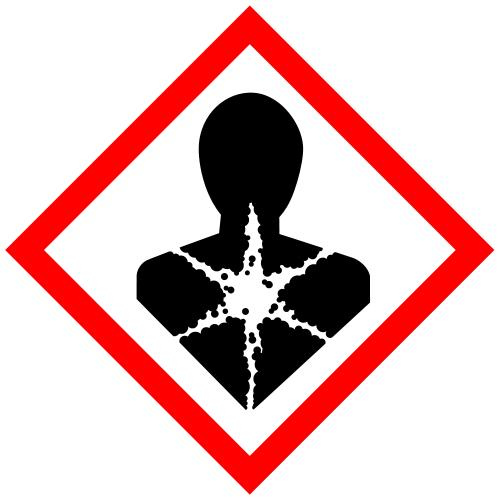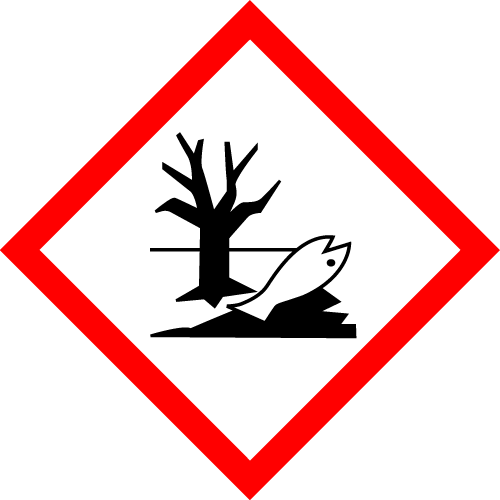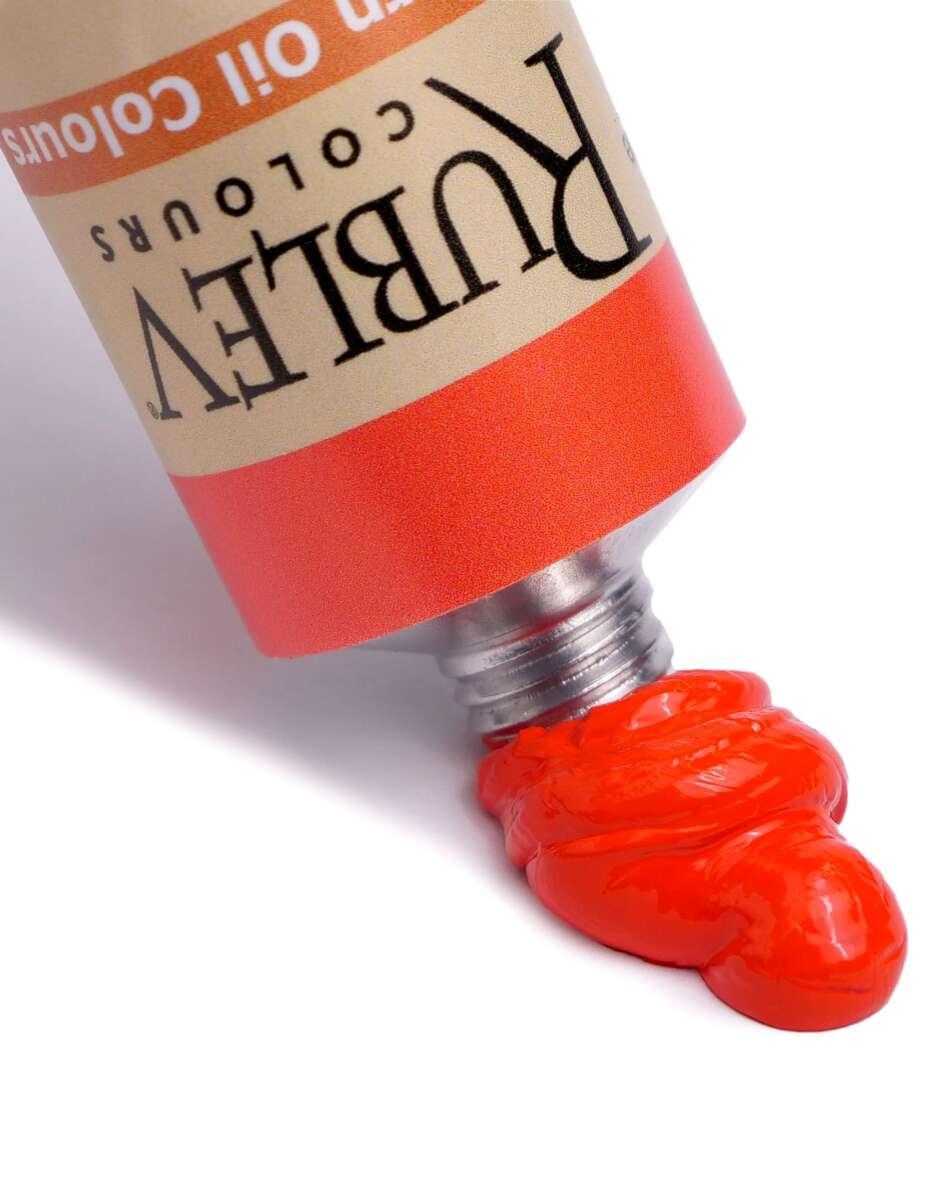Orange Molybdate Oil Paint
A brilliant orange made of lead chromate and lead molybdate and used in plastics, protective coatings, and printing inks, but rarely as an artists' paint. Learn more.
Orange Molybdate is a brilliant orange pigment made by coprecipitation of lead chromate and lead molybdate often in the presence of lead sulfate and used in plastics, protective coatings, and printing inks. Molybdate orange has been widely used in coatings and plastics for many decades during the 20th century because of its bright color and high hiding power. Its use in coatings and plastics today is currently restricted in several countries due to the lead and chromium VI content in its composition. Orange molybdate had a brief history of use by artists for several decades in the last century.
This is the first time it is being reintroduced as an artists' oil color and is now available exclusively from Natural Pigments.
Orange Molybdate is opaque, strongly tinting orange. Its hue is reddish orange, deeper red than minium (red lead) and has a pleasing slightly ropey consistency in oil.
Molybdate orange has been classified as Pigment Red 104 and number 77605 (Molybdate Orange/Red) in the Colour Index, a directory of pigments and dyes published by the UK Society of Dyers and Colourists and the American Association of Textile Chemists and Colorists.
Orange molybdate has not been rated for lightfastness by the ASTM, but independent studies have shown that it remains unchanged in oil under normal atmosphere and can be used with all other pigments without alteration.
History
Mixed crystal pigments of lead chromate and lead molybdate were first described by E. Lederle in a German patent (no. 22F.1.52.30) applied for by the I.G. Farbenindustrie A. G. on August 30, 1930 (see also German patent 574,379, April 12, 1933, and 574,380, April 13 1933; also U.S. patent 1,926,447, September 12, 1933). Although molybdenum orange went into production soon after 1935 for use in printing inks and paints, it is not known that it was used in artists paints until later. According to Susan Lake, it was used by Willem de Kooning and found in combination with other pigments in his 1965 painting Woman.
Permanence and Compatibility
The fastness properties of orange molybdate and red molybdate pigments are comparable with those of the chrome yellows. As with the chrome yellows, the pigment particles can be coated with metal oxides, metal phosphates, silicates, etc., to give stabilized pigments with high color brilliance and good fastness properties, as well as highly stabilized grades with very good resistance to light, weathering, sulfur dioxide, and temperature and with a very low content of acid-soluble lead. (Read more at the pigment Orange Molybdate)
Rublev Colours Orange Molybdate is made using a silicate-coated (encapsulated) grade with very good lightfastness.
Combinations with organic red and yellow pigments give a considerably extended color range. Such combinations have very good stability properties because the lightfastness and weather resistance of many organic red pigments are not adversely affected by molybdate pigments. For example, Colour Index Pigment Red 3 (Toluidine red) is often used in conjunction with molybdate red.
Composition and Permanence
| Orange Molybdate | |
| Color: | Orange Molybdate |
| Binder: | Linseed oil |
| Additive(s): | None |
| Pigment Information | |
| Pigment: | Orange Molybdate |
| Pigment Classification: | Synthetic inorganic |
| Colour Index: | Pigment Red 104 (77629) |
| Chemical Name: | Lead Chromate, Molybdate, Lead Sulfate |
| Chemical Formula: | PbCrO4.PbMoO4.PbSO4 |
| CAS No. | 12656-85-8 |
| Properties | |
| Code: | 403 |
| Series: | 4 |
| Opacity: | Opaque |
| Tinting Strength: | High |
| Drying Rate: | Medium |
| ASTM Lightfastness: | Not Listed |
| Permanence: | A - Permanent |
| Safety Information: | DANGER! HARMFUL IF SWALLOWED OR BY SKIN CONTACT. Contains Lead. Avoid ingestion and skin contact. Wear protective clothing and gloves to prevent contact with broken skin. Never use near children or pets. Conforms to ASTM D-4236. Proposition 65: Warning: This product contains lead, a chemical known to the State of California to cause cancer, birth defects and other reproductive harm. DANGER CONTAINS LEAD / CONTIENT DU PLOMB DO NOT APPLY TO SURFACES ACCESSIBLE TO CHILDREN OR PREGNANT WOMEN. NE PAS APPLIQUER SUR UNE SURFACE ACCESSIBLE AUX ENFANTS OU AUX FEMMES ENCEINTES. Must be used exclusively as material for the purposes of arts, crafts or hobbies, not for use by children. Utiliser uniquement aux fins suivantes comme matériaux pour les besoins d'art, d'artisanat ou passe-temps, pas pour une utilisation par les enfants. |
For a detailed explanation of the terms in the table above, please visit Composition and Permanence.
Notes
Some separation of pigment and oil may occur in Rublev Colours Artist Oils and is a natural process when no wax or stabilizers are added to paint to prevent this from occurring.
All images of color swatches in this web site are only approximations of the actual color of the oil paint. We have taken every care to match the color in these pictures on calibrated color monitors to the actual color. However, because of the wide variance in color monitors, the results you get may vary.
Color Swatch Note: The color swatch was created with a thick application (left side) of color and a tint (right side) made with equal parts of color and titanium white and applied on acrylic primed cotton canvas.
Drawdown Note: The image of the "drawdown" contains a pre-mixed paint film of 6 mil (0.006 inch) thickness applied to a standard test card for the purposes of examining color consistency, opacity and other qualities. The drawdowns show the color full strength (mass tone), on the left, and mixed in a 1:2 ratio with titanium white on the right. The bottom area of the drawdowns is scraped to show undertones.
| Color Names | |
| Common Names: | English: orange molybdate French: d'orange molybdate German: Orange Molybdate Italian: arancione di molibdato Russian: Оранжевый молибдат Spanish: anaranjado de molibdato |
| Alternate Names: | Chrome vermilion; Lead chromate molybdate sulfate; Molybdate chrome orange; Molybdate orange; Molybdenum orange |
| SKU | 820-403 |
|---|---|
| Brand | Rublev Colours |
| Vendor | Natural Pigments |
| Processing Time | Usually ships the next business day. |
| Color | Orange |
| Pigment Type | Inorganic, Synthetic |
DANGER! CONTAINS LEAD. HARMFUL IF SWALLOWED. Avoid ingestion and skin contact. Wear protective clothing and gloves to prevent contact with skin. Never use near children or pets. Read the MSDS for all cautionary statements. Conforms to ASTM D 4236.
DANGER
CONTAINS LEAD / CONTIENT DU PLOMB
DO NOT APPLY TO SURFACES ACCESSIBLE TO CHILDREN OR PREGNANT WOMEN.
NE PAS APPLIQUER SUR UNE SURFACE ACCESSIBLE AUX ENFANTS OU AUX FEMMES ENCEINTES.
Must be used exclusively as material for the purposes of arts, crafts or hobbies, not for use by children. Utiliser uniquement aux fins suivantes comme matériaux pour les besoins d’art, d’artisanat ou passe-temps, pas pour une utilisation par les enfants.
Hazard Pictograms
 |  |  |
| GHS07: Exclamation Mark | GHS08-2: Health Hazard | GHS09: Environment |
Signal Word: Danger
Hazard Designation
H302 Harmful if swallowed.
H332 Harmful if inhaled.
H360 May damage fertility or the unborn child.
H373 May cause damage to organs through prolonged or repeated exposure.
H410 Very toxic to aquatic life with long lasting effects.
Safety Designation
P260 Do not breathe dust/fume/gas/mist/vapors/spray.
P261 Avoid breathing dust/ fume/ gas/ mist/ vapors/ spray.
P280 Wear protective gloves/ clothing/ eye/ face protection.
P281 Use personal protective equipment as required.
P405 Store locked up.
P501 Dispose of contents/ container according to regional, national and international regulations.
![]() WARNING: This product can expose you to chemicals including lead, which is known to the State of California to cause cancer and birth defects or other reproductive harm. For more information go to www.P65Warnings.ca.gov.
WARNING: This product can expose you to chemicals including lead, which is known to the State of California to cause cancer and birth defects or other reproductive harm. For more information go to www.P65Warnings.ca.gov.



